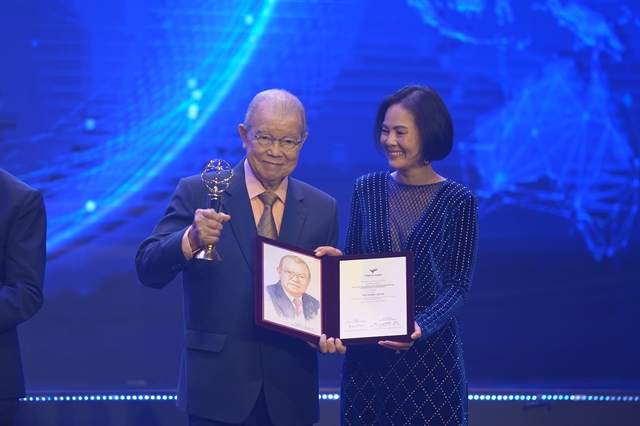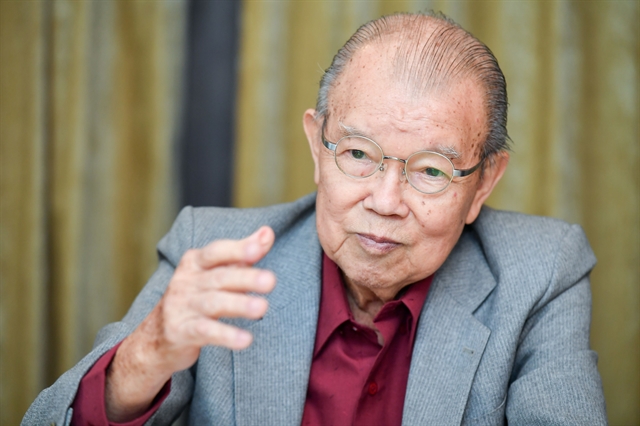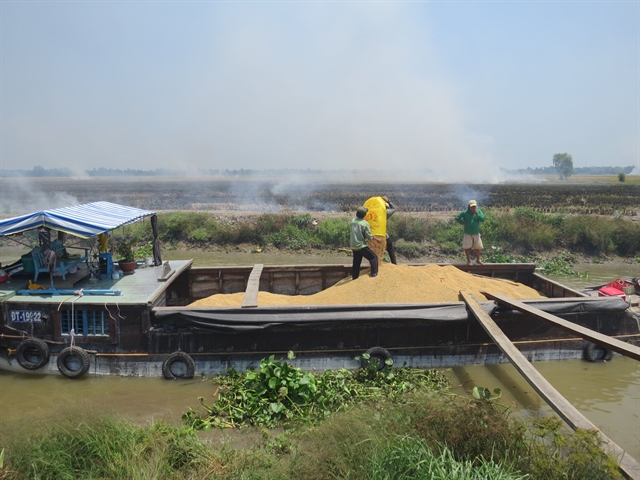 Society
Society

 |
| Professor Võ Tòng Xuân receives the VinFuture Special Prize 2023 for Innovators from Developing Countries for his significant contributions to the invention and advancement of disease-resistant rice varieties, ensuring global food security. — Photo courtesy of VinFuture organiser |
Professor Võ Tòng Xuân and his friend, Professor Gurdev Singh Khush, University of California, Davis, USA, have been honoured with the VinFuture Special Prize 2023 for Innovators from Developing Countries for their significant contributions to the invention and advancement of disease-resistant rice varieties, ensuring global food security.
Dedicating his life to helping farmers reduce suffering due to food shortages, Professor Võ Tòng Xuân has always been passionate about research into finding rice varieties adapted to climate change in Việt Nam. His work has created a revolution in agriculture, not only with Vietnamese farmers but also successfully spreading to many countries around the world, contributing to strengthening food security. Prof. Xuân told Việt Nam News readers about his journey to enhance the value of Vietnamese rice varieties.
You have spent your whole life researching new rice varieties, creating an agricultural revolution and contributing to stabilising food security. How did you pursue this journey?
I have loved farming since I was young. When I was in high school, every time I went to watch my aunt and uncle work in the fields, I saw that the life of a farmer was very miserable. I wanted to study well so I could do something for my homeland.
In grade 10, when I was admitted to Cao Thắng Technical College, I liked mechanical engineering and dreamed of going abroad to study in the US or Germany. But at that time, there was only the chance to study in the Philippines and the major was agriculture.
Still carrying the dream of studying mechanical engineering, I also researched how mechanical engineering could be applied to agriculture. The sugar industry is the field I first pursued. I learned how to grow sugar cane and learned how to make paper from sugarcane bagasse, waiting for the day I could return to apply it in my hometown.
But a turning point in my life came in 1969 when the International Rice Research Institute (IRRI) was built at the school where I studied in the Philippines. Although I also encountered many difficulties when applying to study at the IRRI, I was accepted by IRRI leaders. This was a turning point when I was able to participate in teaching and researching the application of rice varieties at IRRI.
In 1971, I returned home and worked at the College of Agriculture at Cần Thơ University. After nine weeks, I brought the new rice variety back to Việt Nam for application. At that time, in 1972, brown plant hoppers thrived, destroying the varieties of the IRRI. I again asked the institute to provide some new rice varieties that were resistant to brown plant hoppers.
In 1973, I identified varieties IR26 and IR30 that were resistant to brown plant hoppers and gave them to my aunt and uncle for use. The rice was very good, stands straight and had many flowers. Varieties IR26 and IR30 have since been replicated.
 |
| Professor Võ Tòng Xuân. — Photo nhandan.vn |
Was your journey back to Việt Nam to help farmers with new rice varieties difficult?
At that time, I saw the important role of the College of Agriculture. I felt like I had to promote bringing good rice varieties to places where people had not yet used them.
A few months after the country's reunification, students in Tân Châu District, An Giang Province told me that rice varieties IR26, IR30 and IR32 were all destroyed again by brown plant hoppers. People bought all kinds of insecticides to kill the pests, but they were ineffective because the hoppers were drug-resistant.
I went to Tân Châu to investigate and discovered that this was a new type of brown plant hopper. I contacted the Philippines to ask for new rice varieties. They sent some new varieties and we discovered that the IR36 rice variety grew very well and was not eaten by brown plant hoppers.
I sent students from all majors to go to places with brown plant hoppers to help farmers cultivate the new IR36 rice variety. Thanks to the new rice variety, after just one rice crop, farmers could multiply many varieties, eliminating brown plant hoppers. However, this rice variety was not delicious and the quality was not good, so further research had to be done.
I always tell students that Việt Nam has 3.5 million hectares of rice cultivation, while Thailand has more than 10 million hectares. Thai rice varieties are delicious, long, grown once a year, and sell at high prices. In the 1980s and 1990s, when exporting rice, the price of a tonne of Vietnamese rice was only US$250 compared to $800 or more per tonne in Thailand. I told the students that if they wanted to win against Thailand, they must focus on short-term rice farming, plant three crops per year, and they will have nine million hectares of rice growing area each year.
A stable rice variety must be bred for one to eight generations. While I am not familiar with breeding, I advocated research and application. Therefore, I focused on the IR36 rice variety, variety 5404. I asked the IRRI for the 4th-5th generation rice variety so I could breed new rice varieties myself. Gradually, I also had a variety of rice that is delicious, but not fragrant.
However, the price of our rice is lower than that of Thailand because it is not delicious. Therefore, we also tried to research new directions. Fortunately, among my students, Hồ Quang Cua was very interested in researching rice varieties. We discussed bringing new rice varieties back from Thailand. At the IRRI, we have the right to take varieties with aromatic genes, but this variety does not combine with short-term genes. We spent more than 10 years unable to breed new rice varieties. When we tried combining Yellow Flower Sticky rice with short-term genetic rice varieties, we found it feasible. In 2017, we selected the ST24 variety and rated it as the best quality.
After losing the World's Best Rice contest, we continued to research and create the ST25 hybrid line and took it to the competition in 2019. That year, the excellent ST25 rice variety was recognised as the best rice in the world.
 |
| Farmers harvest rice in Đồng Tháp Province. — Photo nhandan.vn |
What was the journey like, for you and your colleagues to bring new rice varieties like IR36 to the world?
By the 1980s, the IR36 rice variety was used globally with a cultivated area of up to 11 million hectares. By 2000, the widespread dissemination of IR36 and other rice varieties contributed significantly to increased rice productivity, with production increasing to 600 million tonnes.
In addition to IR36, IR64 has been widely planted across 10 million hectares within two decades of its introduction to the market, creating a positive impact on the lives of millions of people worldwide.
IR64 was first popularised in the Philippines in 1985, and soon after in Bhutan, Burkina Faso, Cambodia, China, Ecuador, Gambia, India, Indonesia, Mauritania, Mozambique, Việt Nam and the Sahelian regions of West Africa. By 2018, IR64 and its descendants were widely grown in many countries and were the most popular rice varieties in tropical Asia, proving their superiority and special adaptability.
Can you share some advice for Vietnamese scientists?
For scientific researchers in Việt Nam, especially young scientists, I think they have to study seriously and carefully. Vietnamese scientists, our young scientists, must know where we come from and where we are going, from there we can cherish our passion and realise our dreams. — VNS




